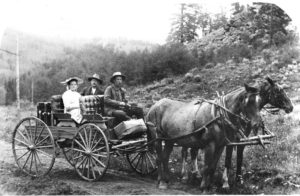By Jennifer Welch
I remember the first day I saw her. She wasn’t a particularly impressive pig. I picked her and a few Durocs out of the litters available and came home with a menagerie of feeder pigs. Our original intention was to eat them all. I had visited several pig breeders and decided, ultimately, that breeding was not for me. Pigs are smelly. And loud. And they eat a lot. And they can gnaw through your femur in minutes flat, flesh included. There were too many reasons to count, as to why we would never become pig farmers, and count them we did. That is, until reason became meaningless and all counts flew out the door … and we decided to breed pigs. Naturally.
A friend had asked me if we wanted a free, one-year-old boar. I’m a sucker for free things so, obviously, I accepted the offer. We brought him home to meet two of the gilts we had raised by hand as feeders, one a purebred Duroc and the other a Duroc X Hampshire. We bred them and then crossed our fingers that we wouldn’t royally screw it all up. When it came time to farrow, we stayed up for 48 hours straight ushering in the new lives to the farm. Belly, our purebred Duroc, did a fantastic job with her babies, requiring very little assistance. Clarabelle Mine (Clara), our Duroc X Hampshire named after a favorite climbing area, had a few stumbles including some damaged teats and piglet losses. By the time we weaned our first litters I was convinced that Clara needed to be culled – relieved of her breeding duties, as it were – and that Belly would be our lead sow. Boy, was I wrong.
An old-timer gave me some advice that was both pertinent to my career and well-timed for Clara: “always give a sow a second chance.” At first I felt like it was time well wasted, but I gave it a shot. When it came time to farrow for the second time, Belly showed a more aggressive attitude and earned her status as a cull pig – sausage and chops in the family freezer. But I was pleasantly surprised by Clara. She had a litter of 14, lost very few piglets, remained calm, and didn’t let the fact that she had lost milk-production in three of her teats slow her down in the least. My choice for lead sow became very clear and, ultimately, my relief that I had given her a second chance became overwhelming. She went on to produce over 100 piglets for us in six years of being on the farm.
[InContentAdTwo] I can say that I have learned everything I know about breeding pigs from Clara. Of course there is always more to learn, but she has given me a hefty leg-up. I’ve raised bottle babies and become attached to the relationship that forms when an animal assumes you are its ultimate caregiver. I’ve hand-raised breeders that need to be culled in order to strengthen the herd and to nourish our family. I’ve watched animals grow from my breeding board, to the dirt, to the rush of blood that comes from their veins when they are harvested. None of it is easy. None of it should be easy. But it is logical. For me, Clara defies logic. Clara gets a pass that not many will receive. She will retire on our fields and live out a happy life as a well-loved, well-respected pig.
Feeding a 600-pound sow for the remainder of her life is not a decision one makes lightly. We are currently one week away from weaning Clara’s final litter from her side and placing her into retirement. For most sows, this equates to being shipped off to the butcher. For me there is no choice in the matter, only a duty owed to a pig that has given me all I have to account for. I have a breeding program I feel confident in, a business plan that grows my farm, and a good sow to thank for it all.
My hope for Clara is that she lives many years in the comfort of my care. Because she knows her name and will move easily from one paddock to another, we will use her to train our feeders to move between the new pastures we will be leasing for them to graze. My hope for Clara is that she knows she is loved. My hope is that she passes peacefully in her sleep, to find her final resting place under a tree on our farm. Knowing farm animals and the way they perish makes this all feel like a pipe dream, but one can still hope, right? Either way I will tell her everyday that I owe her my successes. I will give her my ultimate respect for all that she has taught me. I will carry her with me in my heart, even after she is gone, all 600 pounds of her. She is the good sow. The best sow. The reason for second chances. And carrier of my heart, forever.
Jen Welch lives and writes in the Upper Arkansas River Valley and will forever believe in second chances and big, big love.

